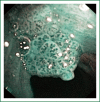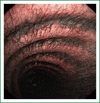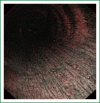Advanced bronchoscopic techniques in diagnosis and staging of lung cancer
- PMID: 24102008
- PMCID: PMC3791497
- DOI: 10.3978/j.issn.2072-1439.2013.05.15
Advanced bronchoscopic techniques in diagnosis and staging of lung cancer
Abstract
The role of advanced brochoscopic diagnostic techniques in detection and staging of lung cancer has steeply increased in recent years. Bronchoscopic imaging techniques became widely available and easy to use. Technical improvement led to merging in technologies making autofluorescence or narrow band imaging incorporated into one bronchoscope. New tools, such as autofluorescence imagining (AFI), narrow band imaging (NBI) or fuji intelligent chromo endoscopy (FICE), found their place in respiratory endoscopy suites. Development of endobronchial ultrasound (EBUS) improved minimally invasive mediastinal staging and diagnosis of peripheral lung lesions. Linear EBUS proven to be complementary to mediastinoscopy. This technique is now available in almost all high volume centers performing bronchoscopy. Radial EBUS with mini-probes and guiding sheaths provides accurate diagnosis of peripheral pulmonary lesions. Combining EBUS guided procedures with rapid on site cytology (ROSE) increases diagnostic yield even more. Electromagnetic navigation technology (EMN) is also widely used for diagnosis of peripheral lesions. Future development will certainly lead to new improvements in technology and creation of new sophisticated tools for research in respiratory endoscopy. Broncho-microscopy, alveoloscopy, optical coherence tomography are some of the new research techniques emerging for rapid technological development.
Keywords: Autofluorescence bronchoscopy (AFB); endobronchial ultrasound (EBUS); interventional bronchoscopy; narrow band imagning (NBI).
Figures













References
-
- McErlean A, Ginsberg MS. Epidemiology of lung cancer. Semin Roentgenol 2011;46:173-7 - PubMed
-
- Wahidi MM, Herth FJ, Ernst A. State of the art: interventional pulmonology. Chest 2007;131:261-74 - PubMed
-
- Sutedja G.New techniques for early detection of lung cancer. Eur Respir J Suppl 2003;39:57s-66s - PubMed
-
- Colt HG, Murgu SD. Interventional bronchoscopy from bench to bedside: new techniques for early lung cancer detection. Clin Chest Med 2010;31:29-37 - PubMed
-
- Perin B, Zarić B, Becker HD, et al. Interventional pulmonology. In: Jeremic B. eds. Medical Radiology, 2011, Advances in Radiation Oncology in Lung Cancer. Heidelberg: Springer Verlag, 2011:45-52.
Publication types
LinkOut - more resources
Full Text Sources
